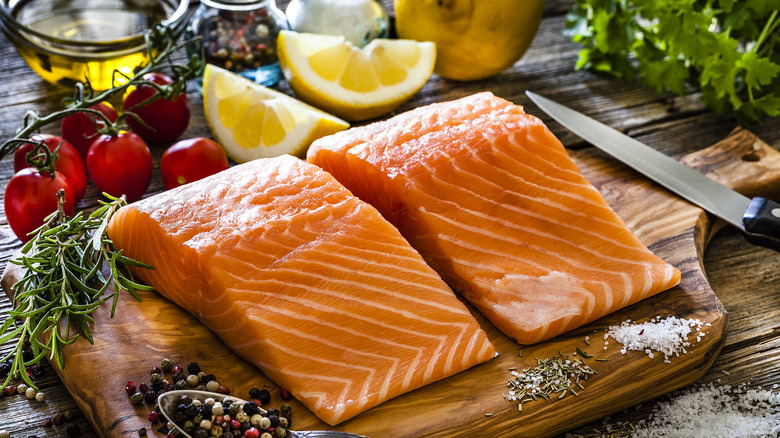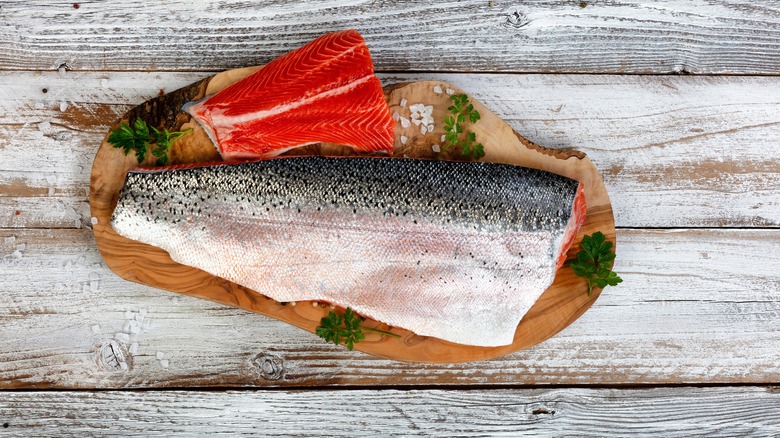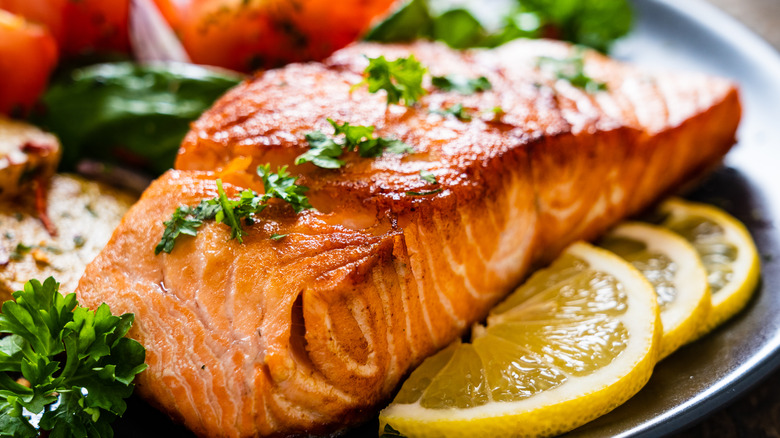Pouring Boiling Water Over Salmon Fillets Is A Game Changer
Most seafood lovers fall firmly on a chosen side of the skin/no skin salmon debate. Those who adamantly oppose leaving the skin on a salmon fillet cite a strong "fishy" taste and an unappealing layer of fatty gray matter beneath the skin. But removing the skin presents some formidable obstacles — and more than a few indignant protests by skin-on advocates.
If you want that skin off anyway, then give it a go. But good luck removing it without a mangled mess on your hands and, ultimately, your plate. Unless you're privy to a simple, ingenious chef hack that involves literally one ingredient and comes straight from your kitchen faucet: water.
Boiling water is all you need to make the bottom layer of skin peel right off a salmon fillet. It doesn't cause the salmon to start cooking or affect the cooked texture or taste, and it takes less than five minutes.
Just place your salmon fillet skin-side-up on a tray, and bring a kettle of water to a rolling boil. Slowly pour a single level of boiling-hot water over the exposed salmon skin, and let it sit for about three minutes. Ideally, place it on a grated surface so the water runs off to an underneath pan.
Then use your fingers to gently pull the skin off the salmon fillet. Start at the top and peel it slowly across the entire surface. You'll literally be holding the entire once-attached skin, leaving a pristine skinless piece of fish that's ready to cook.
Cooking with skinless salmon fillets
Be aware that you may end up with some gray-matter remnants after using the boiling-water method of salmon skin removal. Sometimes known as the "fat line," this layer of fat tucks between the salmon skin and flesh and is perfectly edible. But, depending on the freshness of the fillet, it may retain bits of the excessively fishy flavor you're hoping to avoid.
You may not notice this fatty layer before cooking, but after it turns gray, you can gently scrape the tiny remaining bits off with a thin-tipped sharp knife. It may be aesthetically damaging and difficult to perform on a piece of hot fish, so it's OK just to leave it be.
Disapproving frowns in restaurants are common when requesting salmon sans the skin, possibly because it's easier to keep a fillet looking tidy and appealing with the skin holding it all together. But many recipes for cooking at home actually call for skinless salmon. Generally, pan-fried salmon is a go-to method for skinless fish, especially salmon. All you need is some heated olive oil in the bottom of a skillet and seasonings per taste. Just sizzle the salmon until it turns starts to turn slightly pinkish white on the bottom two-thirds of the fillet, then flip and finish for a crunchy, flavorful top.
For an extra burst of flavor, try using a marinade over the top before cooking. Other options include grilling, smoking, searing, and baking.
Do you really want to remove that salmon skin?
Though many professional chefs insist skin-on fish is more flavorful, you've probably already chosen sides. Skin off is a perfectly legitimate choice, especially if it makes you eat more of the highly nutritious salmon species.
Salmon is well known for harboring loads of vitamins, protein, and beneficial minerals such as phosphorous and niacin. But did you know that, according to Healthline, one of the most notable things about salmon rests within the skin? That would be the super-food Omega-3 fatty acids, an essential polyunsaturated fat for human health that the body fails to produce on its own. The Mayo Clinic explains how it potentially helps with everything from heart health to muscle and cell function, blood pressure control, and more.
On the flip side of that obvious health benefit are a few caveats. Water pollutants such as Methylmercury and PCBs can nestle within salmon skin, including pesticides used in some farm-raised salmon operations. Health professionals advise choosing wild-caught salmon whenever possible if you plan to retain the skin. Pregnant women and young children should consider the skin-off option to be safe.
The debate over fish skin, especially salmon, may rage on — but now you have an easy option for having things your way.



